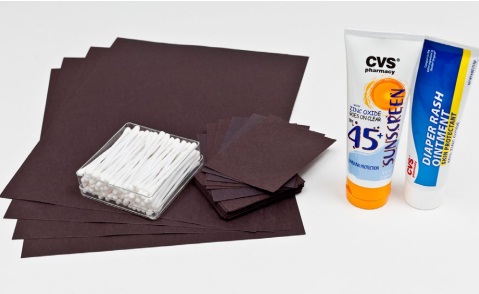





Published on Apr 02, 2024
No one wants the "lifeguard look" of white sunblock smeared on your nose. But sunblocks containing zinc oxide absorb ultraviolet light to protect your skin. New sunblocks with zinc oxide nanoparticles maintain this protection while disappearing into your skin. In this activity, visitors apply both traditional and nano-scale zinc oxide creams to paper to test the difference. A simple comparison of a dot pattern at different scales demonstrates how larger particles reflect more visible light. Visitors will find out what this could mean for their skin's health on their next trip to the beach.
• Visitors will understand how nano-scale particles are used in mineral sunblocks to increase their transparency.
• Strips of black construction paper (7 x 15 cm)
• Zinc oxide ointment (non-nano sunblock)
• Sunscreen with zinc oxide (nano-sunblock)
• Paper towels (optional)

• Picture with large white dots/black background
• Picture with small white dots/black background
• List of common mineral sunblocks/sunscreens
1. Lay out all supplies.
2. You may want to have paper towels on hand to wipe up any excess sunscreen and protect the workspace with newspaper or a towel.
1. Begin by asking the visitors if they use sunblock. Discuss that the purpose of using sunblocks/sunscreens is to protect the skin from ultraviolet light, which can cause short-term (sunburn) and long-term (pre-mature aging and skin cancer) damage.
2. Apply a small dot (half the size of a pea is more than enough) of both types of zinc oxide onto a strip of black construction paper (be consistent when you give strips to multiple visitors – e.g. nano-sunblock always on the left side). Challenge visitors to rub each dab of sunblock into the paper until it disappears. Once they have completed this task, ask them to identify which dot disappeared more quickly.

3. Explain that both sunblocks contain zinc oxide, a mineral that is very effective at absorbing UV radiation to prevent it from reaching your skin. The difference between the two sunblocks is in the size of the zinc oxide particles. The regular zinc oxide leaves a more visible film (a.k.a. “the lifeguard nose”) because the particles are large enough to reflect visible light. The nano-sunblock is transparent because the zinc oxide nanoparticles are too small to reflect visible light. They are still large enough to absorb UV radiation, so protection is equally effective.
4. Show visitors the two pictures of large and small white dots. Ask the visitors which dots are easier to see. The visitors should choose the picture with the large dots. This image represents the regular sunblock – the large white dots reflect more visible light than the smaller dots, so they are more visible. The image of the small dots represents the nano-sunblock – each smaller particle reflects less visible light, so collectively they are harder to see and the nano-sunblock appears transparent. The large dot image has been scaled down and tiled to form the image of the small dots, so the ratio of black to white is the same in both pictures; only the distribution is different.
5. Discuss the list of common sunblocks. (Optional) Print and provide visitors with a copy if they are interested.
1. Throw away used construction paper.
2. Gather all materials and return to storage.
the diameter of a zinc oxide molecule is reduced below the wavelength of visible light (380–780 nm), the nanoparticle no longer scatters visible light so the substance containing the mineral will look transparent. However, the particles are still larger than the wavelength of ultraviolet light and the chemical composition of the particle is not altered, so zinc oxide does not lose its ability to absorb UV radiation.
Although the public and manufacturers often use the words ”sunblock” and “sunscreen” interchangeably, they technically refer to two different types of sun protectants. Sunblocks refer to sun protectants that contain minerals such as zinc oxide or titanium dioxide. They block about 99% of UV radiation, but non-nano formulations are opaque in nature and users rarely apply the amount recommended for effective protection as a result. Sunscreens refer to chemically based sun protectants, few of which individually protect against both UV-A (320–400 nm) and UV-B (290–320 nm) radiation and are usually combined into broad-spectrum products.
Although chemical sunscreens also degrade when exposed to UV light, they are more transparent than traditional mineral sunblocks when rubbed on the skin. In light of this, chemical sunscreens tend to be more popular than mineral sun blocks, even though mineral sun the diameter of a zinc oxide molecule is reduced below the wavelength of visible light (380–780 nm), the nanoparticle no longer scatters visible light so the substance containing the mineral will look transparent. However, the particles are still larger than the wavelength of ultraviolet light and the chemical composition of the particle is not altered, so zinc oxide does not lose its ability to absorb UV radiation.
Although the public and manufacturers often use the words ”sunblock” and “sunscreen” interchangeably, they technically refer to two different types of sun protectants. Sunblocks refer to sun protectants that contain minerals such as zinc oxide or titanium dioxide. They block about 99% of UV radiation, but non-nano formulations are opaque in nature and users rarely apply the amount recommended for effective protection as a result. Sunscreens refer to chemically based sun protectants, few of which individually protect against both UV-A (320–400 nm) and UV-B (290–320 nm) radiation and are usually combined into broad-spectrum products. Although chemical sunscreens also degrade when exposed to UV light, they are more transparent than traditional mineral sunblocks when rubbed on the skin. In light of this, chemical sunscreens tend to be more popular than mineral sun blocks, even though mineral sun.
Visitors may want to try applying the different sunblocks on their skin. Although the sunblocks should be safe to use, some visitors may have sensitive skin conditions, so stick to the construction paper unless they are adults or have explicit permission from an adult. (If they do apply it to their skin, putting one sunblock on the back of each hand facilitates easy comparison.)
1. NASA-Advanced Technology, Invisible Sunblock: http://slsd.jsc.nasa.gov/bso/advtech/?viewFile=Invisible Sunblock
2. The Art and Science of Encapsulation http://www.swri.edu/3pubs/ttoday/summer95/microeng.htm